UOW Library Ground Floor Computer Usage: A Research Proposal
VerifiedAdded on 2021/06/16
|12
|2729
|137
Report
AI Summary
This research proposal assesses the usage of computers on the ground floor of the UOW library. The study aims to answer the question: "What is the computer usage in the ground floor library in UOW?" The methodology involves observing and counting computer usage over 20 visits, resulting in quantitative data. The data will be analyzed using RStudio and a one-sample t-test to determine if the number of computers in use is at least half the total number available. The proposal includes a literature review, outlines the significance of the problem, and details the expected outcomes of the research. The study emphasizes the importance of computers in modern libraries and their role in providing access to information and facilitating research for students. The study will determine the extent of computer usage in the UOW library.
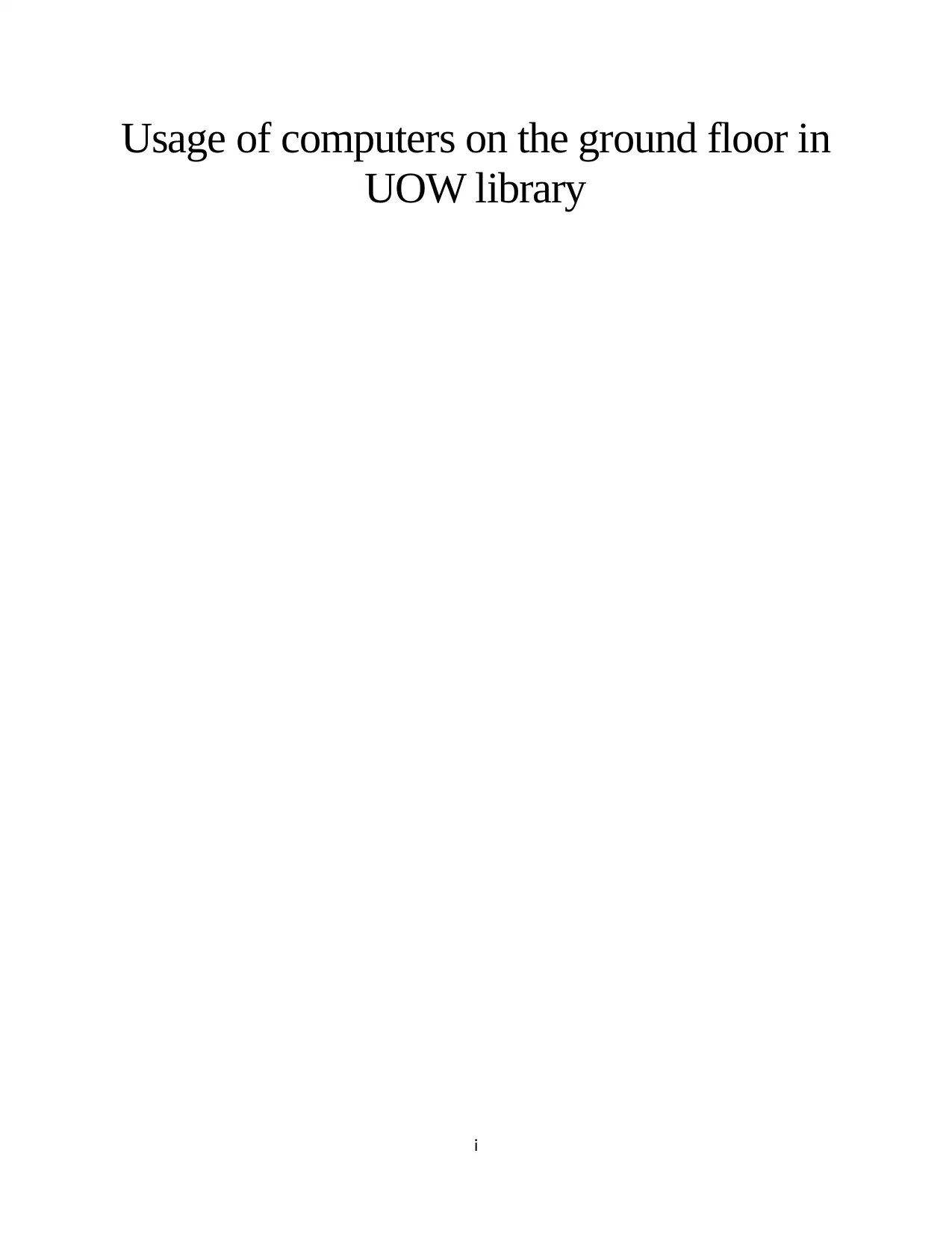
Usage of computers on the ground floor in
UOW library
i
UOW library
i
Paraphrase This Document
Need a fresh take? Get an instant paraphrase of this document with our AI Paraphraser
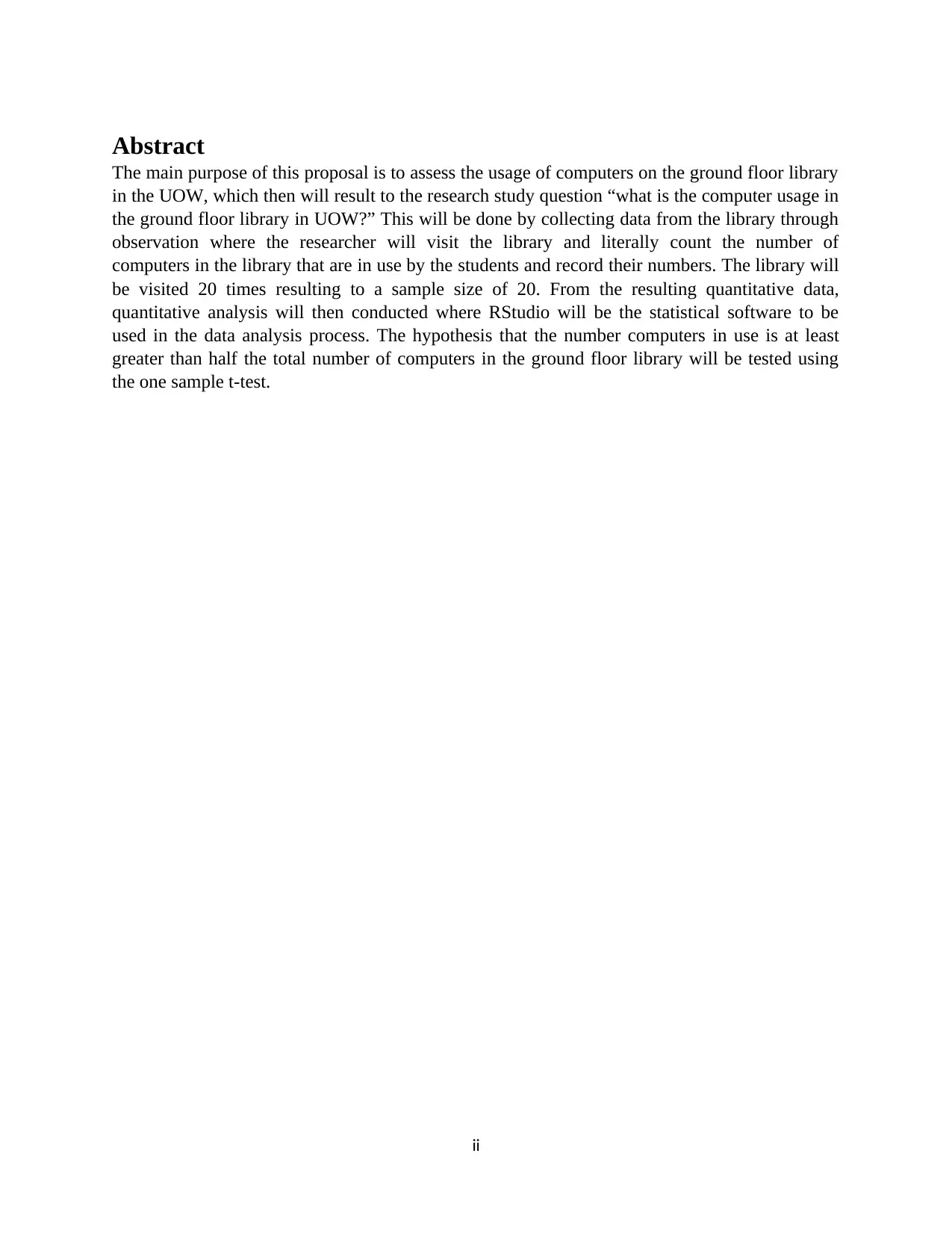
Abstract
The main purpose of this proposal is to assess the usage of computers on the ground floor library
in the UOW, which then will result to the research study question “what is the computer usage in
the ground floor library in UOW?” This will be done by collecting data from the library through
observation where the researcher will visit the library and literally count the number of
computers in the library that are in use by the students and record their numbers. The library will
be visited 20 times resulting to a sample size of 20. From the resulting quantitative data,
quantitative analysis will then conducted where RStudio will be the statistical software to be
used in the data analysis process. The hypothesis that the number computers in use is at least
greater than half the total number of computers in the ground floor library will be tested using
the one sample t-test.
ii
The main purpose of this proposal is to assess the usage of computers on the ground floor library
in the UOW, which then will result to the research study question “what is the computer usage in
the ground floor library in UOW?” This will be done by collecting data from the library through
observation where the researcher will visit the library and literally count the number of
computers in the library that are in use by the students and record their numbers. The library will
be visited 20 times resulting to a sample size of 20. From the resulting quantitative data,
quantitative analysis will then conducted where RStudio will be the statistical software to be
used in the data analysis process. The hypothesis that the number computers in use is at least
greater than half the total number of computers in the ground floor library will be tested using
the one sample t-test.
ii
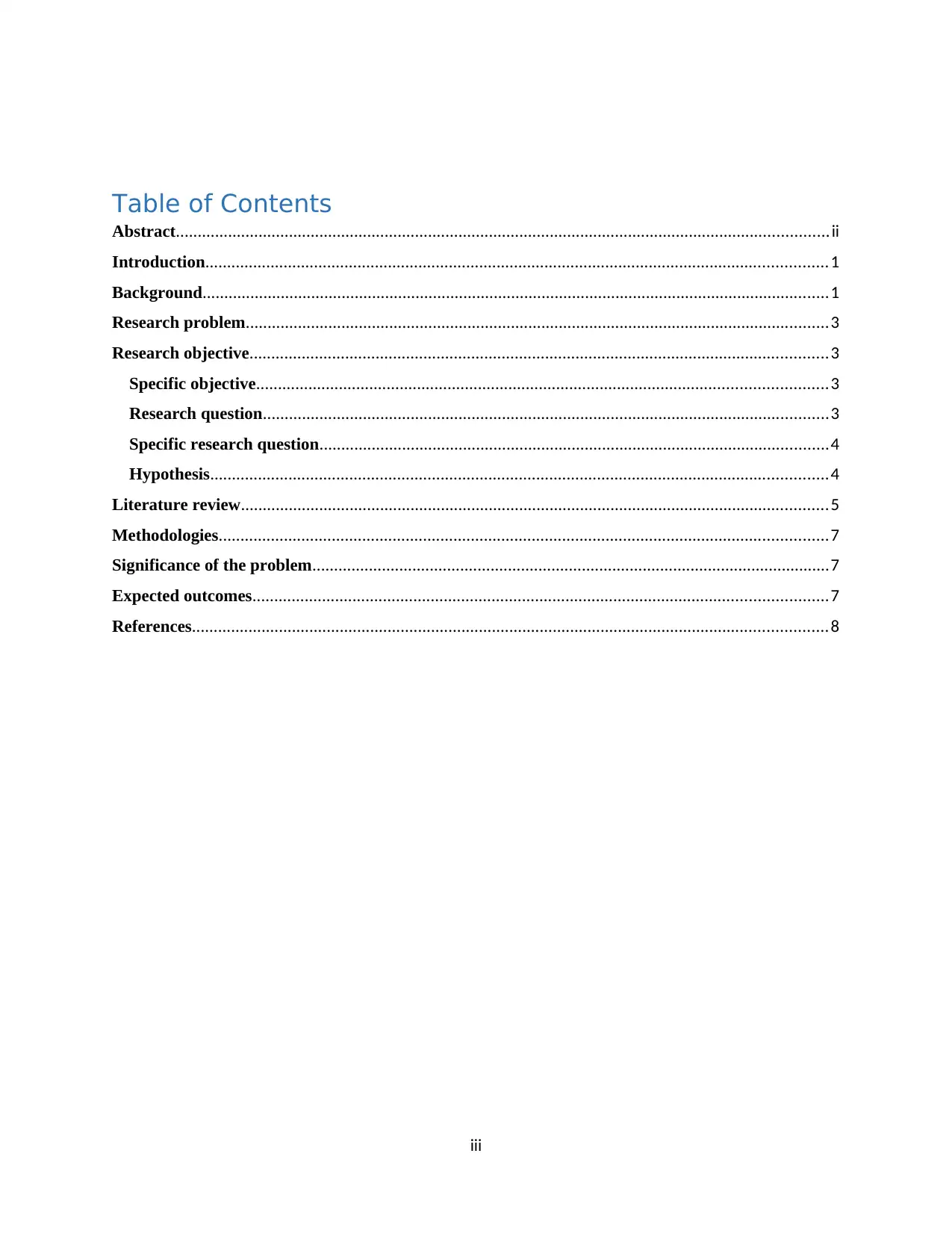
Table of Contents
Abstract......................................................................................................................................................ii
Introduction...............................................................................................................................................1
Background................................................................................................................................................1
Research problem......................................................................................................................................3
Research objective.....................................................................................................................................3
Specific objective...................................................................................................................................3
Research question..................................................................................................................................3
Specific research question.....................................................................................................................4
Hypothesis..............................................................................................................................................4
Literature review.......................................................................................................................................5
Methodologies............................................................................................................................................7
Significance of the problem.......................................................................................................................7
Expected outcomes....................................................................................................................................7
References..................................................................................................................................................8
iii
Abstract......................................................................................................................................................ii
Introduction...............................................................................................................................................1
Background................................................................................................................................................1
Research problem......................................................................................................................................3
Research objective.....................................................................................................................................3
Specific objective...................................................................................................................................3
Research question..................................................................................................................................3
Specific research question.....................................................................................................................4
Hypothesis..............................................................................................................................................4
Literature review.......................................................................................................................................5
Methodologies............................................................................................................................................7
Significance of the problem.......................................................................................................................7
Expected outcomes....................................................................................................................................7
References..................................................................................................................................................8
iii
⊘ This is a preview!⊘
Do you want full access?
Subscribe today to unlock all pages.

Trusted by 1+ million students worldwide
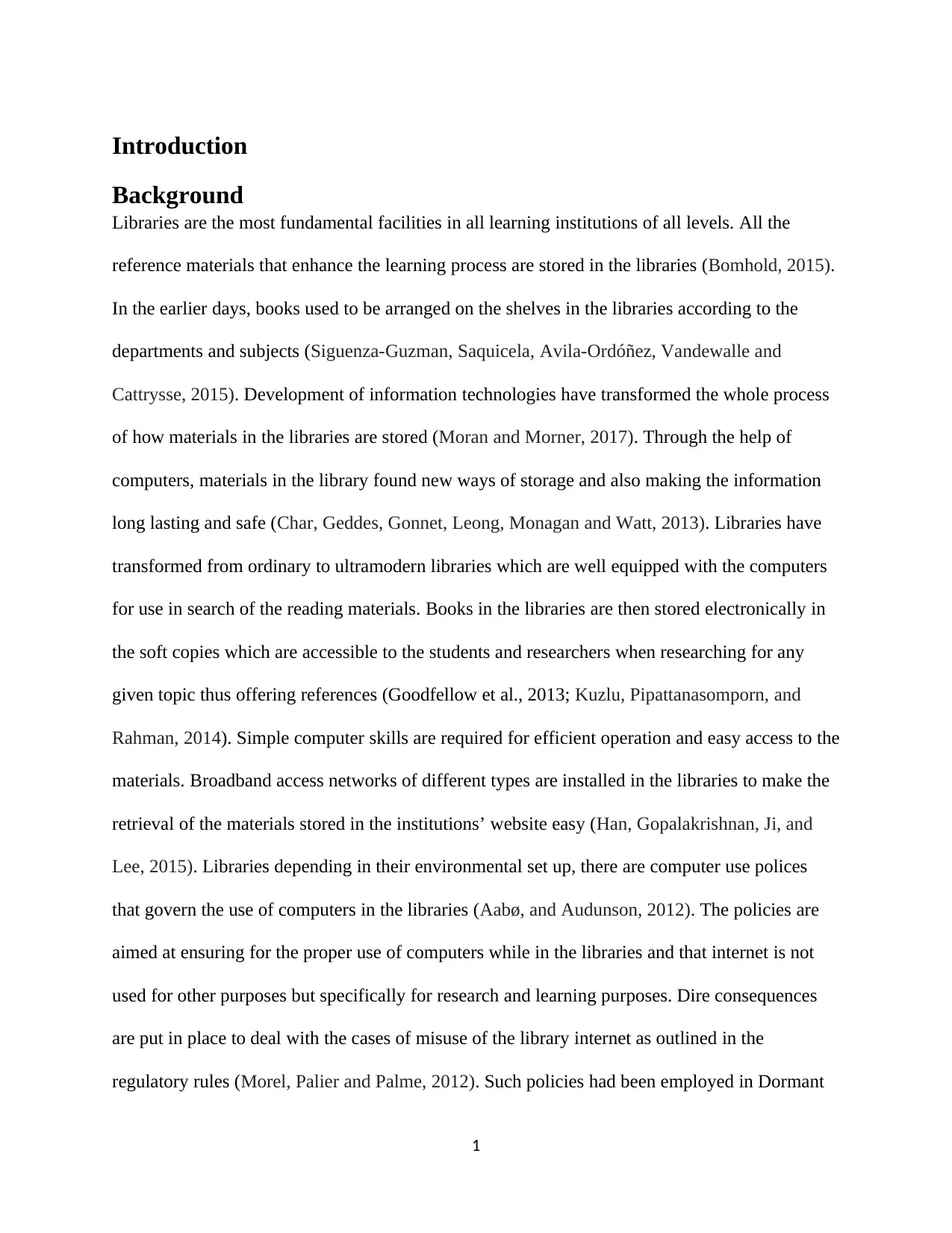
Introduction
Background
Libraries are the most fundamental facilities in all learning institutions of all levels. All the
reference materials that enhance the learning process are stored in the libraries (Bomhold, 2015).
In the earlier days, books used to be arranged on the shelves in the libraries according to the
departments and subjects (Siguenza-Guzman, Saquicela, Avila-Ordóñez, Vandewalle and
Cattrysse, 2015). Development of information technologies have transformed the whole process
of how materials in the libraries are stored (Moran and Morner, 2017). Through the help of
computers, materials in the library found new ways of storage and also making the information
long lasting and safe (Char, Geddes, Gonnet, Leong, Monagan and Watt, 2013). Libraries have
transformed from ordinary to ultramodern libraries which are well equipped with the computers
for use in search of the reading materials. Books in the libraries are then stored electronically in
the soft copies which are accessible to the students and researchers when researching for any
given topic thus offering references (Goodfellow et al., 2013; Kuzlu, Pipattanasomporn, and
Rahman, 2014). Simple computer skills are required for efficient operation and easy access to the
materials. Broadband access networks of different types are installed in the libraries to make the
retrieval of the materials stored in the institutions’ website easy (Han, Gopalakrishnan, Ji, and
Lee, 2015). Libraries depending in their environmental set up, there are computer use polices
that govern the use of computers in the libraries (Aabø, and Audunson, 2012). The policies are
aimed at ensuring for the proper use of computers while in the libraries and that internet is not
used for other purposes but specifically for research and learning purposes. Dire consequences
are put in place to deal with the cases of misuse of the library internet as outlined in the
regulatory rules (Morel, Palier and Palme, 2012). Such policies had been employed in Dormant
1
Background
Libraries are the most fundamental facilities in all learning institutions of all levels. All the
reference materials that enhance the learning process are stored in the libraries (Bomhold, 2015).
In the earlier days, books used to be arranged on the shelves in the libraries according to the
departments and subjects (Siguenza-Guzman, Saquicela, Avila-Ordóñez, Vandewalle and
Cattrysse, 2015). Development of information technologies have transformed the whole process
of how materials in the libraries are stored (Moran and Morner, 2017). Through the help of
computers, materials in the library found new ways of storage and also making the information
long lasting and safe (Char, Geddes, Gonnet, Leong, Monagan and Watt, 2013). Libraries have
transformed from ordinary to ultramodern libraries which are well equipped with the computers
for use in search of the reading materials. Books in the libraries are then stored electronically in
the soft copies which are accessible to the students and researchers when researching for any
given topic thus offering references (Goodfellow et al., 2013; Kuzlu, Pipattanasomporn, and
Rahman, 2014). Simple computer skills are required for efficient operation and easy access to the
materials. Broadband access networks of different types are installed in the libraries to make the
retrieval of the materials stored in the institutions’ website easy (Han, Gopalakrishnan, Ji, and
Lee, 2015). Libraries depending in their environmental set up, there are computer use polices
that govern the use of computers in the libraries (Aabø, and Audunson, 2012). The policies are
aimed at ensuring for the proper use of computers while in the libraries and that internet is not
used for other purposes but specifically for research and learning purposes. Dire consequences
are put in place to deal with the cases of misuse of the library internet as outlined in the
regulatory rules (Morel, Palier and Palme, 2012). Such policies had been employed in Dormant
1
Paraphrase This Document
Need a fresh take? Get an instant paraphrase of this document with our AI Paraphraser
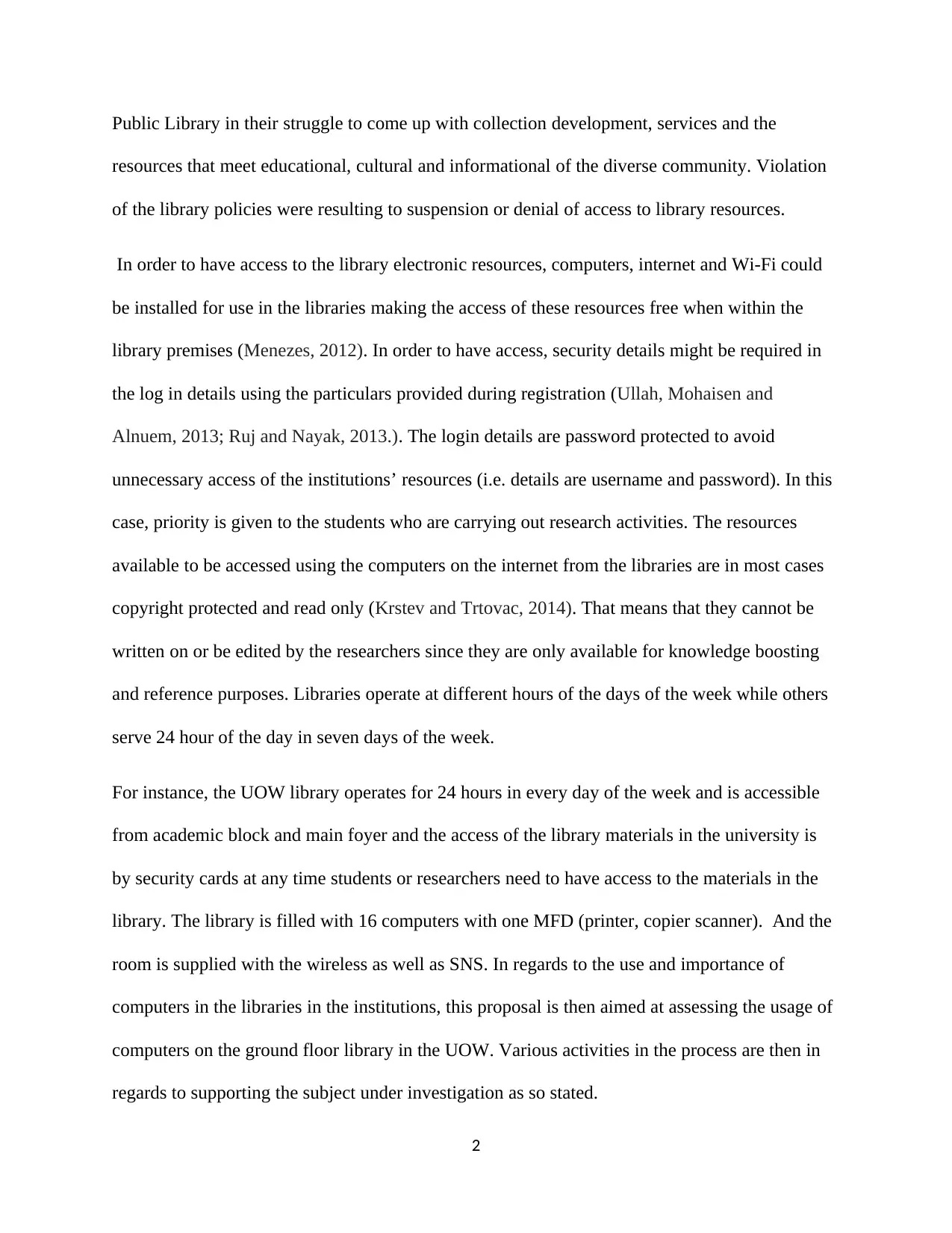
Public Library in their struggle to come up with collection development, services and the
resources that meet educational, cultural and informational of the diverse community. Violation
of the library policies were resulting to suspension or denial of access to library resources.
In order to have access to the library electronic resources, computers, internet and Wi-Fi could
be installed for use in the libraries making the access of these resources free when within the
library premises (Menezes, 2012). In order to have access, security details might be required in
the log in details using the particulars provided during registration (Ullah, Mohaisen and
Alnuem, 2013; Ruj and Nayak, 2013.). The login details are password protected to avoid
unnecessary access of the institutions’ resources (i.e. details are username and password). In this
case, priority is given to the students who are carrying out research activities. The resources
available to be accessed using the computers on the internet from the libraries are in most cases
copyright protected and read only (Krstev and Trtovac, 2014). That means that they cannot be
written on or be edited by the researchers since they are only available for knowledge boosting
and reference purposes. Libraries operate at different hours of the days of the week while others
serve 24 hour of the day in seven days of the week.
For instance, the UOW library operates for 24 hours in every day of the week and is accessible
from academic block and main foyer and the access of the library materials in the university is
by security cards at any time students or researchers need to have access to the materials in the
library. The library is filled with 16 computers with one MFD (printer, copier scanner). And the
room is supplied with the wireless as well as SNS. In regards to the use and importance of
computers in the libraries in the institutions, this proposal is then aimed at assessing the usage of
computers on the ground floor library in the UOW. Various activities in the process are then in
regards to supporting the subject under investigation as so stated.
2
resources that meet educational, cultural and informational of the diverse community. Violation
of the library policies were resulting to suspension or denial of access to library resources.
In order to have access to the library electronic resources, computers, internet and Wi-Fi could
be installed for use in the libraries making the access of these resources free when within the
library premises (Menezes, 2012). In order to have access, security details might be required in
the log in details using the particulars provided during registration (Ullah, Mohaisen and
Alnuem, 2013; Ruj and Nayak, 2013.). The login details are password protected to avoid
unnecessary access of the institutions’ resources (i.e. details are username and password). In this
case, priority is given to the students who are carrying out research activities. The resources
available to be accessed using the computers on the internet from the libraries are in most cases
copyright protected and read only (Krstev and Trtovac, 2014). That means that they cannot be
written on or be edited by the researchers since they are only available for knowledge boosting
and reference purposes. Libraries operate at different hours of the days of the week while others
serve 24 hour of the day in seven days of the week.
For instance, the UOW library operates for 24 hours in every day of the week and is accessible
from academic block and main foyer and the access of the library materials in the university is
by security cards at any time students or researchers need to have access to the materials in the
library. The library is filled with 16 computers with one MFD (printer, copier scanner). And the
room is supplied with the wireless as well as SNS. In regards to the use and importance of
computers in the libraries in the institutions, this proposal is then aimed at assessing the usage of
computers on the ground floor library in the UOW. Various activities in the process are then in
regards to supporting the subject under investigation as so stated.
2
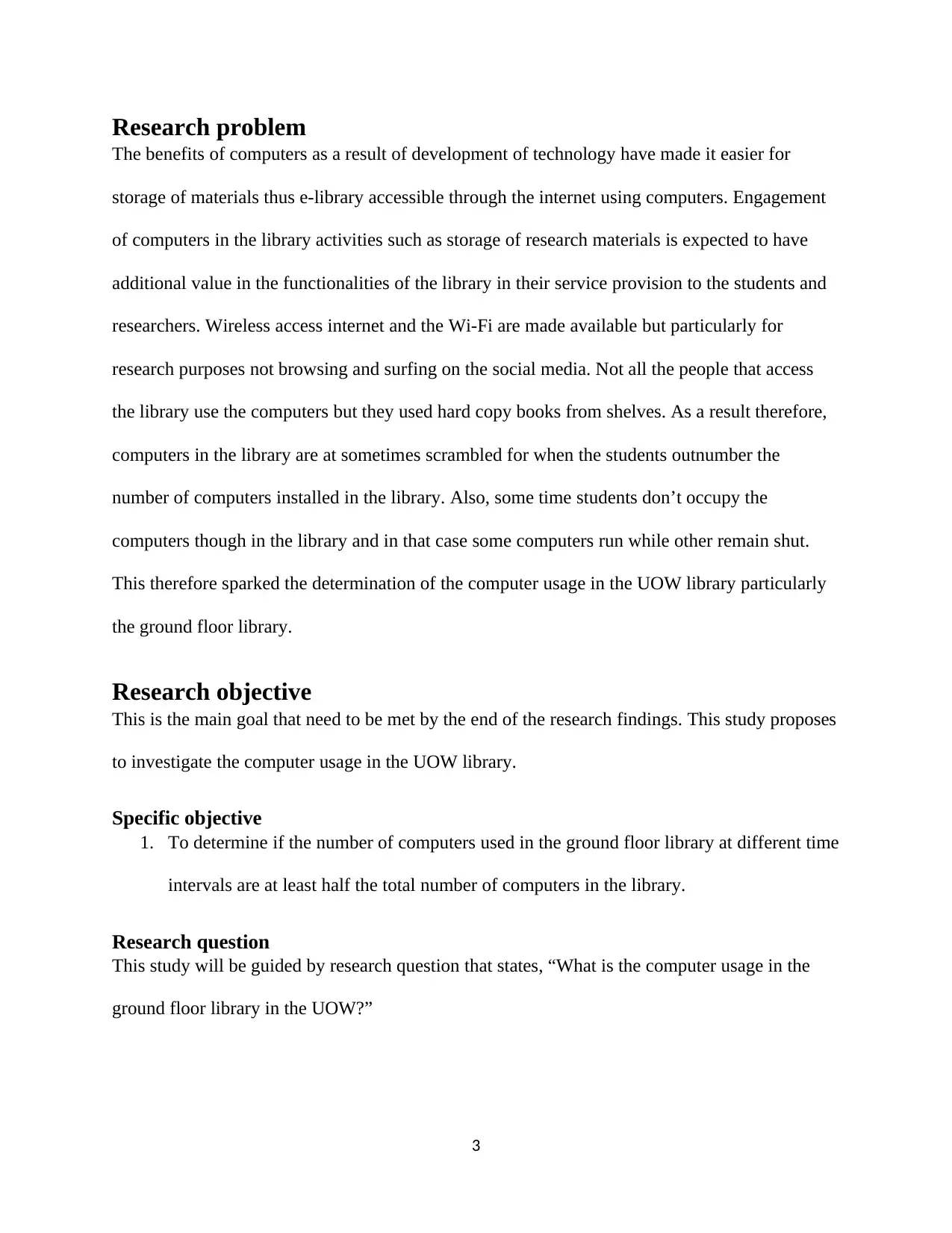
Research problem
The benefits of computers as a result of development of technology have made it easier for
storage of materials thus e-library accessible through the internet using computers. Engagement
of computers in the library activities such as storage of research materials is expected to have
additional value in the functionalities of the library in their service provision to the students and
researchers. Wireless access internet and the Wi-Fi are made available but particularly for
research purposes not browsing and surfing on the social media. Not all the people that access
the library use the computers but they used hard copy books from shelves. As a result therefore,
computers in the library are at sometimes scrambled for when the students outnumber the
number of computers installed in the library. Also, some time students don’t occupy the
computers though in the library and in that case some computers run while other remain shut.
This therefore sparked the determination of the computer usage in the UOW library particularly
the ground floor library.
Research objective
This is the main goal that need to be met by the end of the research findings. This study proposes
to investigate the computer usage in the UOW library.
Specific objective
1. To determine if the number of computers used in the ground floor library at different time
intervals are at least half the total number of computers in the library.
Research question
This study will be guided by research question that states, “What is the computer usage in the
ground floor library in the UOW?”
3
The benefits of computers as a result of development of technology have made it easier for
storage of materials thus e-library accessible through the internet using computers. Engagement
of computers in the library activities such as storage of research materials is expected to have
additional value in the functionalities of the library in their service provision to the students and
researchers. Wireless access internet and the Wi-Fi are made available but particularly for
research purposes not browsing and surfing on the social media. Not all the people that access
the library use the computers but they used hard copy books from shelves. As a result therefore,
computers in the library are at sometimes scrambled for when the students outnumber the
number of computers installed in the library. Also, some time students don’t occupy the
computers though in the library and in that case some computers run while other remain shut.
This therefore sparked the determination of the computer usage in the UOW library particularly
the ground floor library.
Research objective
This is the main goal that need to be met by the end of the research findings. This study proposes
to investigate the computer usage in the UOW library.
Specific objective
1. To determine if the number of computers used in the ground floor library at different time
intervals are at least half the total number of computers in the library.
Research question
This study will be guided by research question that states, “What is the computer usage in the
ground floor library in the UOW?”
3
⊘ This is a preview!⊘
Do you want full access?
Subscribe today to unlock all pages.

Trusted by 1+ million students worldwide
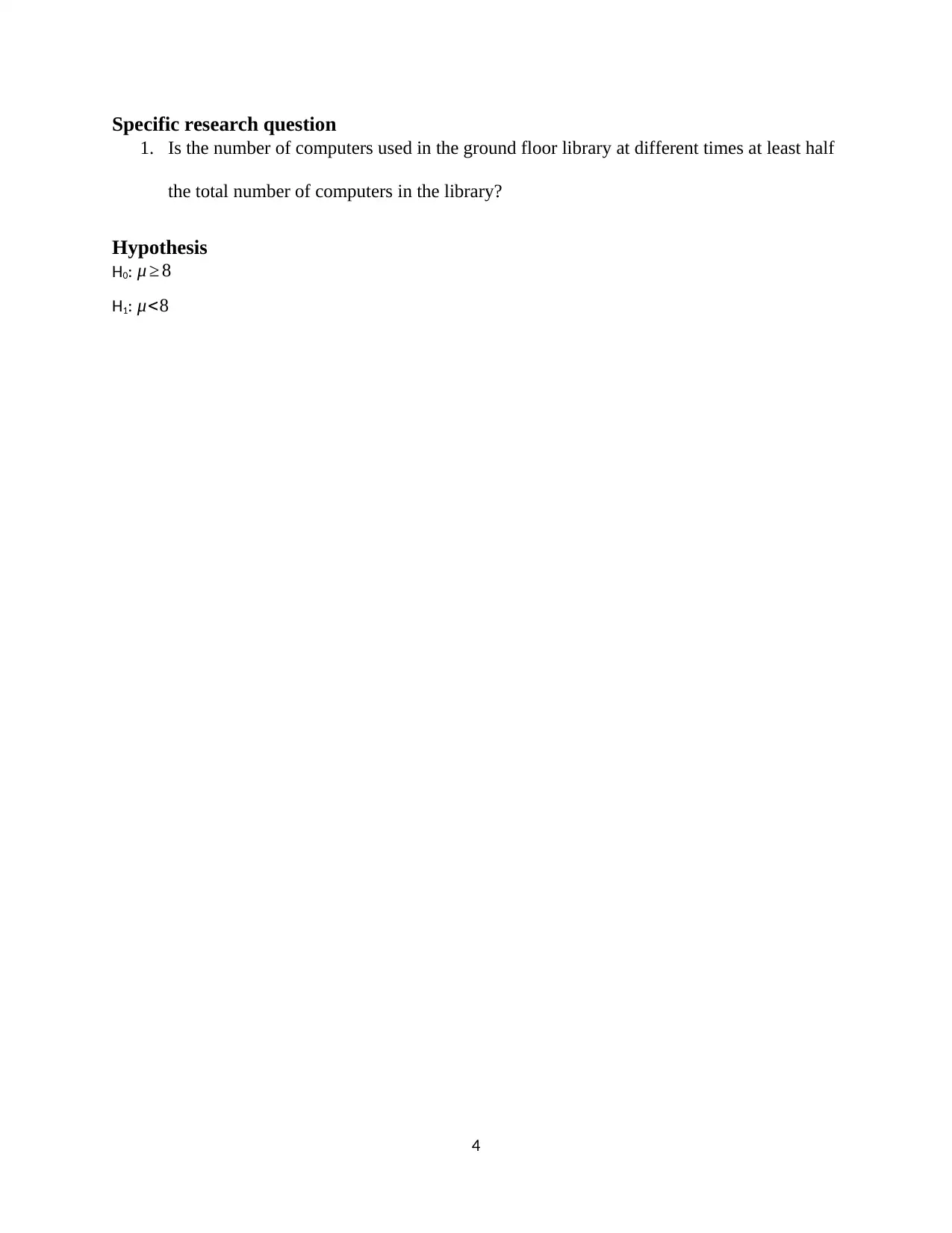
Specific research question
1. Is the number of computers used in the ground floor library at different times at least half
the total number of computers in the library?
Hypothesis
H0: μ ≥ 8
H1: μ<8
4
1. Is the number of computers used in the ground floor library at different times at least half
the total number of computers in the library?
Hypothesis
H0: μ ≥ 8
H1: μ<8
4
Paraphrase This Document
Need a fresh take? Get an instant paraphrase of this document with our AI Paraphraser
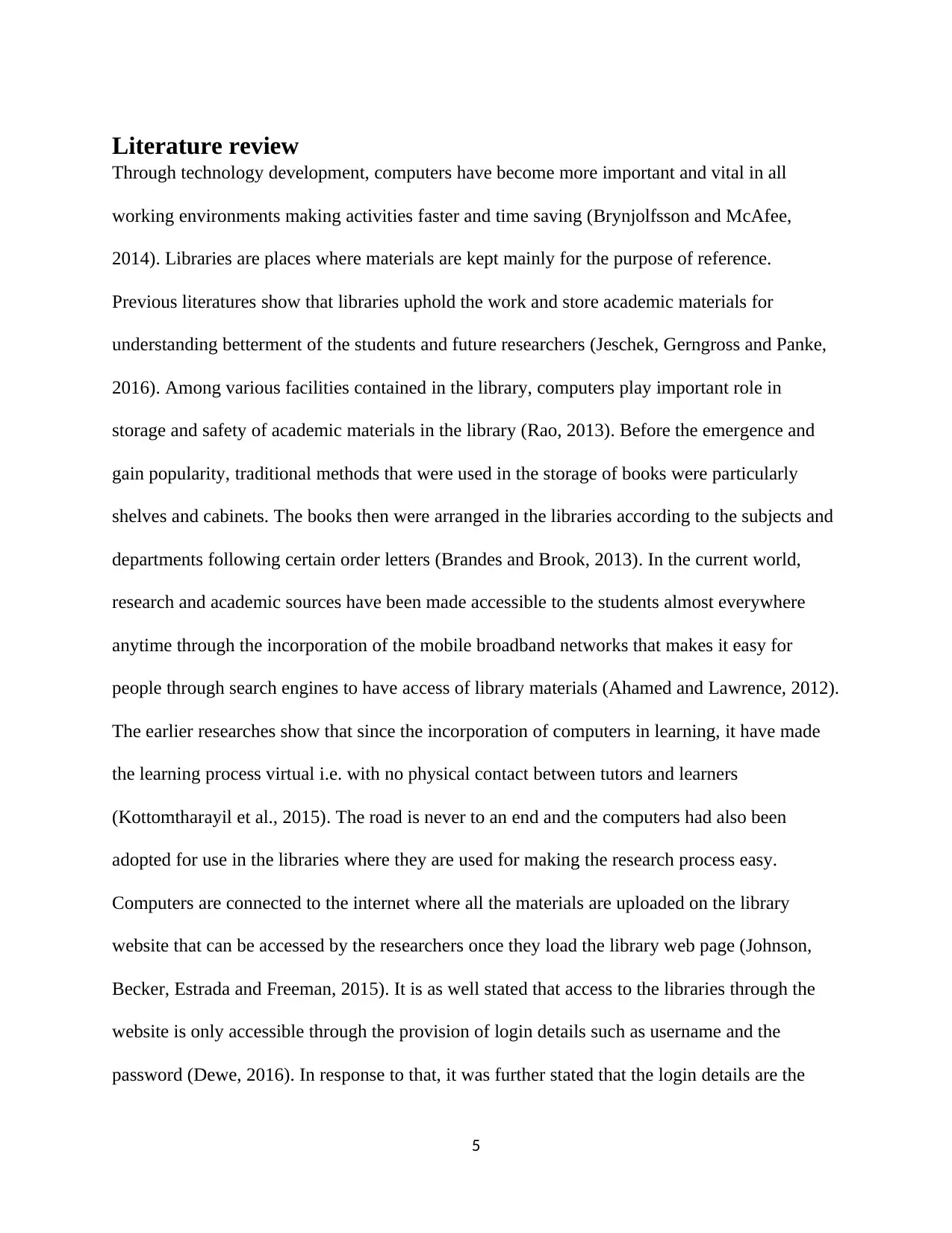
Literature review
Through technology development, computers have become more important and vital in all
working environments making activities faster and time saving (Brynjolfsson and McAfee,
2014). Libraries are places where materials are kept mainly for the purpose of reference.
Previous literatures show that libraries uphold the work and store academic materials for
understanding betterment of the students and future researchers (Jeschek, Gerngross and Panke,
2016). Among various facilities contained in the library, computers play important role in
storage and safety of academic materials in the library (Rao, 2013). Before the emergence and
gain popularity, traditional methods that were used in the storage of books were particularly
shelves and cabinets. The books then were arranged in the libraries according to the subjects and
departments following certain order letters (Brandes and Brook, 2013). In the current world,
research and academic sources have been made accessible to the students almost everywhere
anytime through the incorporation of the mobile broadband networks that makes it easy for
people through search engines to have access of library materials (Ahamed and Lawrence, 2012).
The earlier researches show that since the incorporation of computers in learning, it have made
the learning process virtual i.e. with no physical contact between tutors and learners
(Kottomtharayil et al., 2015). The road is never to an end and the computers had also been
adopted for use in the libraries where they are used for making the research process easy.
Computers are connected to the internet where all the materials are uploaded on the library
website that can be accessed by the researchers once they load the library web page (Johnson,
Becker, Estrada and Freeman, 2015). It is as well stated that access to the libraries through the
website is only accessible through the provision of login details such as username and the
password (Dewe, 2016). In response to that, it was further stated that the login details are the
5
Through technology development, computers have become more important and vital in all
working environments making activities faster and time saving (Brynjolfsson and McAfee,
2014). Libraries are places where materials are kept mainly for the purpose of reference.
Previous literatures show that libraries uphold the work and store academic materials for
understanding betterment of the students and future researchers (Jeschek, Gerngross and Panke,
2016). Among various facilities contained in the library, computers play important role in
storage and safety of academic materials in the library (Rao, 2013). Before the emergence and
gain popularity, traditional methods that were used in the storage of books were particularly
shelves and cabinets. The books then were arranged in the libraries according to the subjects and
departments following certain order letters (Brandes and Brook, 2013). In the current world,
research and academic sources have been made accessible to the students almost everywhere
anytime through the incorporation of the mobile broadband networks that makes it easy for
people through search engines to have access of library materials (Ahamed and Lawrence, 2012).
The earlier researches show that since the incorporation of computers in learning, it have made
the learning process virtual i.e. with no physical contact between tutors and learners
(Kottomtharayil et al., 2015). The road is never to an end and the computers had also been
adopted for use in the libraries where they are used for making the research process easy.
Computers are connected to the internet where all the materials are uploaded on the library
website that can be accessed by the researchers once they load the library web page (Johnson,
Becker, Estrada and Freeman, 2015). It is as well stated that access to the libraries through the
website is only accessible through the provision of login details such as username and the
password (Dewe, 2016). In response to that, it was further stated that the login details are the
5
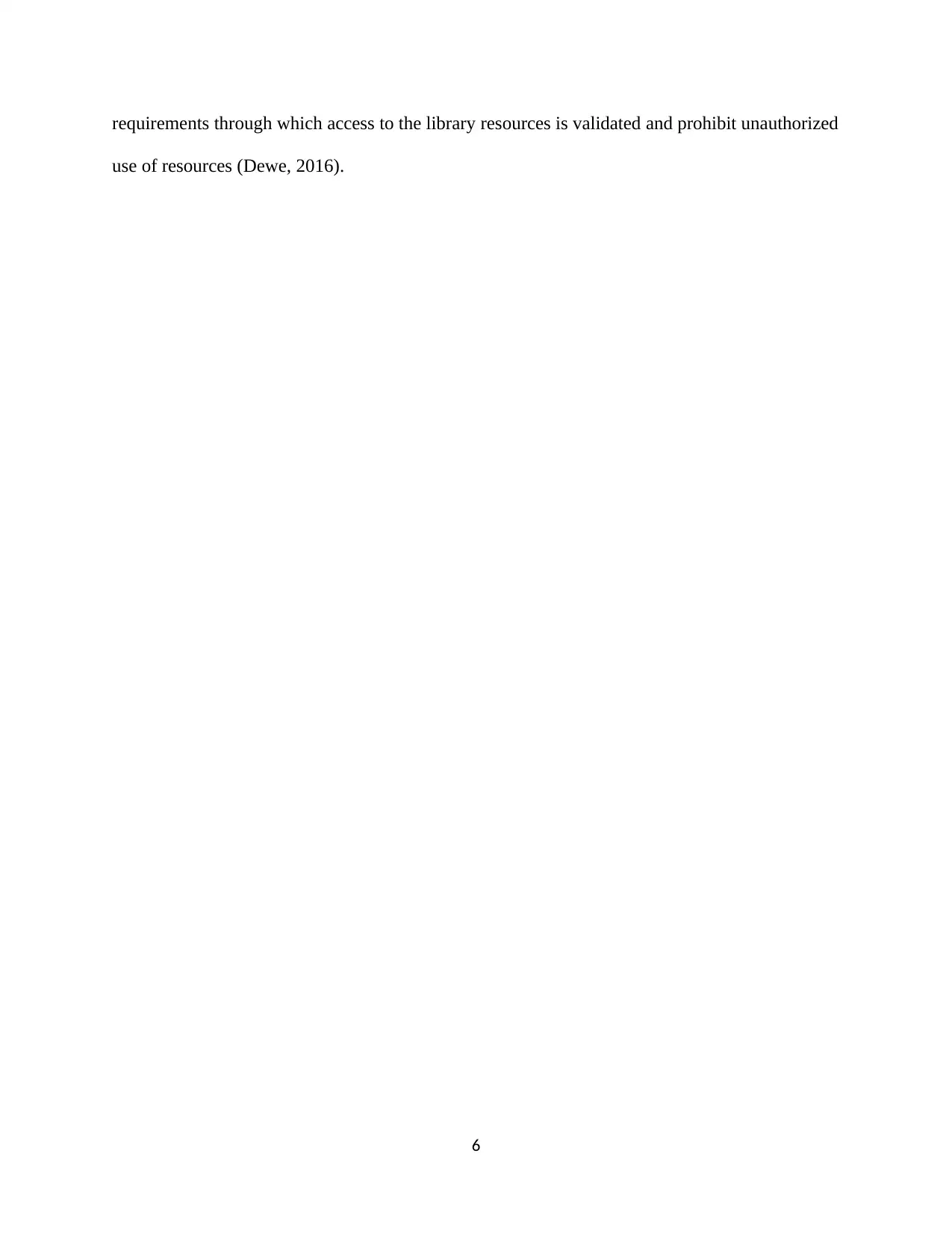
requirements through which access to the library resources is validated and prohibit unauthorized
use of resources (Dewe, 2016).
6
use of resources (Dewe, 2016).
6
⊘ This is a preview!⊘
Do you want full access?
Subscribe today to unlock all pages.

Trusted by 1+ million students worldwide
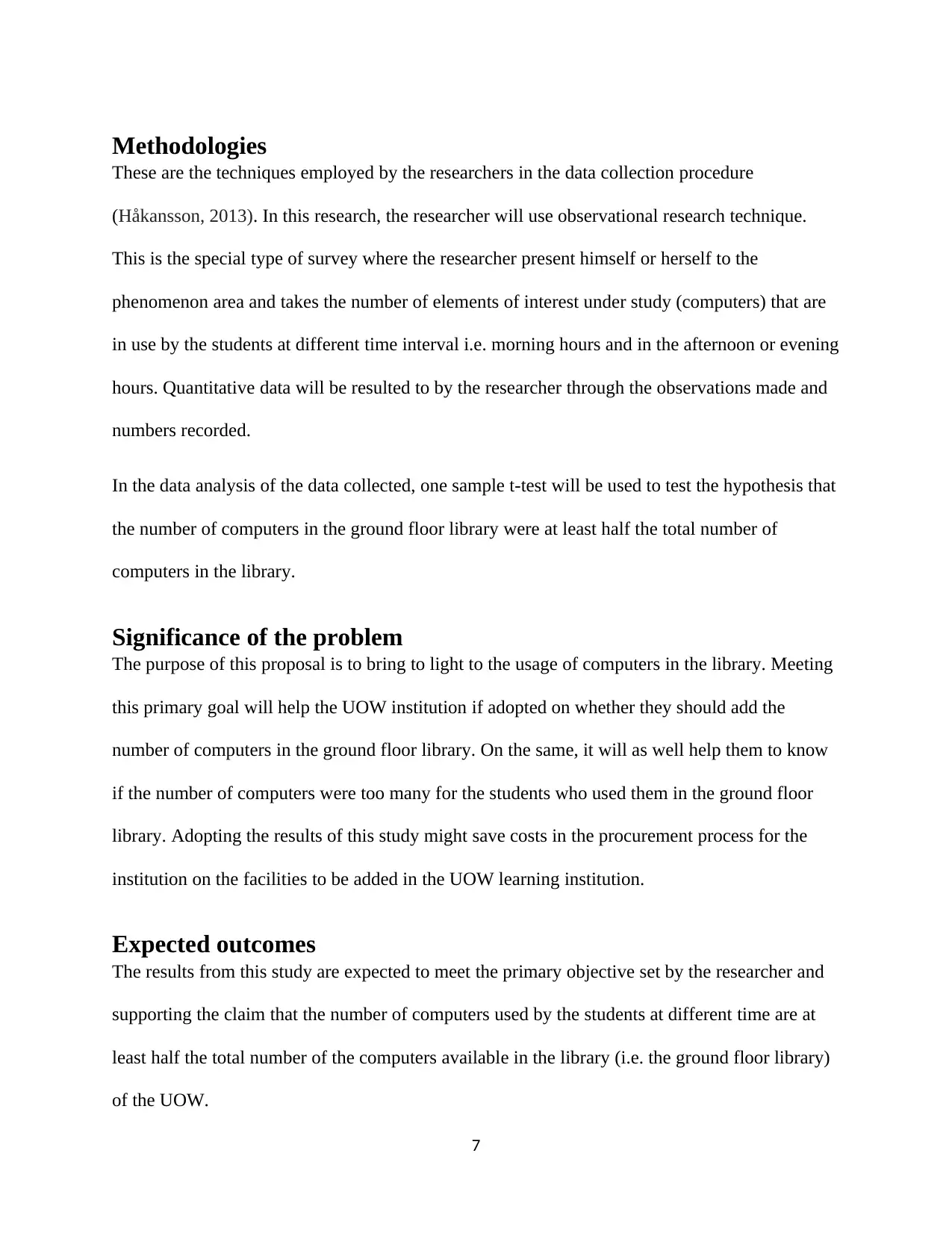
Methodologies
These are the techniques employed by the researchers in the data collection procedure
(Håkansson, 2013). In this research, the researcher will use observational research technique.
This is the special type of survey where the researcher present himself or herself to the
phenomenon area and takes the number of elements of interest under study (computers) that are
in use by the students at different time interval i.e. morning hours and in the afternoon or evening
hours. Quantitative data will be resulted to by the researcher through the observations made and
numbers recorded.
In the data analysis of the data collected, one sample t-test will be used to test the hypothesis that
the number of computers in the ground floor library were at least half the total number of
computers in the library.
Significance of the problem
The purpose of this proposal is to bring to light to the usage of computers in the library. Meeting
this primary goal will help the UOW institution if adopted on whether they should add the
number of computers in the ground floor library. On the same, it will as well help them to know
if the number of computers were too many for the students who used them in the ground floor
library. Adopting the results of this study might save costs in the procurement process for the
institution on the facilities to be added in the UOW learning institution.
Expected outcomes
The results from this study are expected to meet the primary objective set by the researcher and
supporting the claim that the number of computers used by the students at different time are at
least half the total number of the computers available in the library (i.e. the ground floor library)
of the UOW.
7
These are the techniques employed by the researchers in the data collection procedure
(Håkansson, 2013). In this research, the researcher will use observational research technique.
This is the special type of survey where the researcher present himself or herself to the
phenomenon area and takes the number of elements of interest under study (computers) that are
in use by the students at different time interval i.e. morning hours and in the afternoon or evening
hours. Quantitative data will be resulted to by the researcher through the observations made and
numbers recorded.
In the data analysis of the data collected, one sample t-test will be used to test the hypothesis that
the number of computers in the ground floor library were at least half the total number of
computers in the library.
Significance of the problem
The purpose of this proposal is to bring to light to the usage of computers in the library. Meeting
this primary goal will help the UOW institution if adopted on whether they should add the
number of computers in the ground floor library. On the same, it will as well help them to know
if the number of computers were too many for the students who used them in the ground floor
library. Adopting the results of this study might save costs in the procurement process for the
institution on the facilities to be added in the UOW learning institution.
Expected outcomes
The results from this study are expected to meet the primary objective set by the researcher and
supporting the claim that the number of computers used by the students at different time are at
least half the total number of the computers available in the library (i.e. the ground floor library)
of the UOW.
7
Paraphrase This Document
Need a fresh take? Get an instant paraphrase of this document with our AI Paraphraser
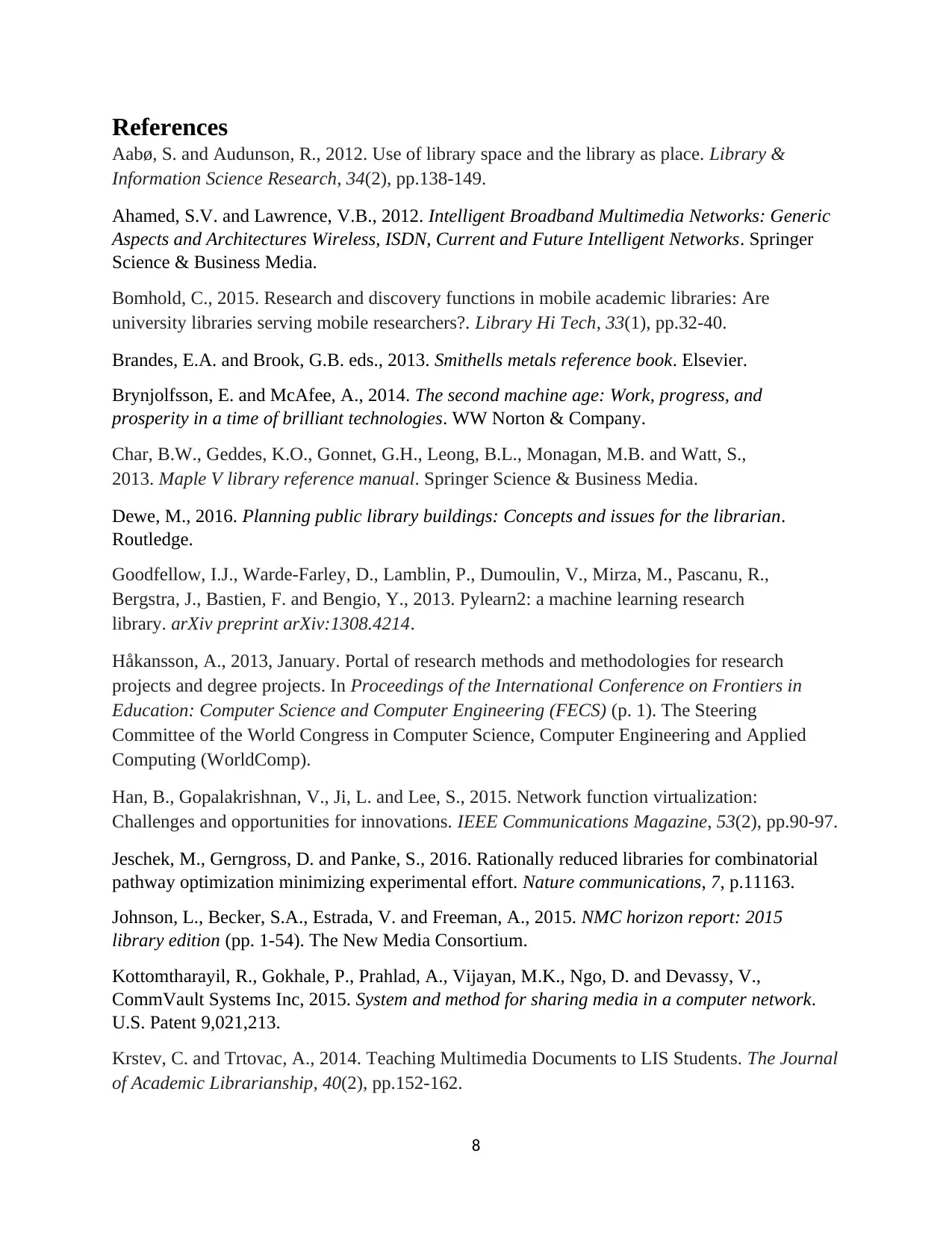
References
Aabø, S. and Audunson, R., 2012. Use of library space and the library as place. Library &
Information Science Research, 34(2), pp.138-149.
Ahamed, S.V. and Lawrence, V.B., 2012. Intelligent Broadband Multimedia Networks: Generic
Aspects and Architectures Wireless, ISDN, Current and Future Intelligent Networks. Springer
Science & Business Media.
Bomhold, C., 2015. Research and discovery functions in mobile academic libraries: Are
university libraries serving mobile researchers?. Library Hi Tech, 33(1), pp.32-40.
Brandes, E.A. and Brook, G.B. eds., 2013. Smithells metals reference book. Elsevier.
Brynjolfsson, E. and McAfee, A., 2014. The second machine age: Work, progress, and
prosperity in a time of brilliant technologies. WW Norton & Company.
Char, B.W., Geddes, K.O., Gonnet, G.H., Leong, B.L., Monagan, M.B. and Watt, S.,
2013. Maple V library reference manual. Springer Science & Business Media.
Dewe, M., 2016. Planning public library buildings: Concepts and issues for the librarian.
Routledge.
Goodfellow, I.J., Warde-Farley, D., Lamblin, P., Dumoulin, V., Mirza, M., Pascanu, R.,
Bergstra, J., Bastien, F. and Bengio, Y., 2013. Pylearn2: a machine learning research
library. arXiv preprint arXiv:1308.4214.
Håkansson, A., 2013, January. Portal of research methods and methodologies for research
projects and degree projects. In Proceedings of the International Conference on Frontiers in
Education: Computer Science and Computer Engineering (FECS) (p. 1). The Steering
Committee of the World Congress in Computer Science, Computer Engineering and Applied
Computing (WorldComp).
Han, B., Gopalakrishnan, V., Ji, L. and Lee, S., 2015. Network function virtualization:
Challenges and opportunities for innovations. IEEE Communications Magazine, 53(2), pp.90-97.
Jeschek, M., Gerngross, D. and Panke, S., 2016. Rationally reduced libraries for combinatorial
pathway optimization minimizing experimental effort. Nature communications, 7, p.11163.
Johnson, L., Becker, S.A., Estrada, V. and Freeman, A., 2015. NMC horizon report: 2015
library edition (pp. 1-54). The New Media Consortium.
Kottomtharayil, R., Gokhale, P., Prahlad, A., Vijayan, M.K., Ngo, D. and Devassy, V.,
CommVault Systems Inc, 2015. System and method for sharing media in a computer network.
U.S. Patent 9,021,213.
Krstev, C. and Trtovac, A., 2014. Teaching Multimedia Documents to LIS Students. The Journal
of Academic Librarianship, 40(2), pp.152-162.
8
Aabø, S. and Audunson, R., 2012. Use of library space and the library as place. Library &
Information Science Research, 34(2), pp.138-149.
Ahamed, S.V. and Lawrence, V.B., 2012. Intelligent Broadband Multimedia Networks: Generic
Aspects and Architectures Wireless, ISDN, Current and Future Intelligent Networks. Springer
Science & Business Media.
Bomhold, C., 2015. Research and discovery functions in mobile academic libraries: Are
university libraries serving mobile researchers?. Library Hi Tech, 33(1), pp.32-40.
Brandes, E.A. and Brook, G.B. eds., 2013. Smithells metals reference book. Elsevier.
Brynjolfsson, E. and McAfee, A., 2014. The second machine age: Work, progress, and
prosperity in a time of brilliant technologies. WW Norton & Company.
Char, B.W., Geddes, K.O., Gonnet, G.H., Leong, B.L., Monagan, M.B. and Watt, S.,
2013. Maple V library reference manual. Springer Science & Business Media.
Dewe, M., 2016. Planning public library buildings: Concepts and issues for the librarian.
Routledge.
Goodfellow, I.J., Warde-Farley, D., Lamblin, P., Dumoulin, V., Mirza, M., Pascanu, R.,
Bergstra, J., Bastien, F. and Bengio, Y., 2013. Pylearn2: a machine learning research
library. arXiv preprint arXiv:1308.4214.
Håkansson, A., 2013, January. Portal of research methods and methodologies for research
projects and degree projects. In Proceedings of the International Conference on Frontiers in
Education: Computer Science and Computer Engineering (FECS) (p. 1). The Steering
Committee of the World Congress in Computer Science, Computer Engineering and Applied
Computing (WorldComp).
Han, B., Gopalakrishnan, V., Ji, L. and Lee, S., 2015. Network function virtualization:
Challenges and opportunities for innovations. IEEE Communications Magazine, 53(2), pp.90-97.
Jeschek, M., Gerngross, D. and Panke, S., 2016. Rationally reduced libraries for combinatorial
pathway optimization minimizing experimental effort. Nature communications, 7, p.11163.
Johnson, L., Becker, S.A., Estrada, V. and Freeman, A., 2015. NMC horizon report: 2015
library edition (pp. 1-54). The New Media Consortium.
Kottomtharayil, R., Gokhale, P., Prahlad, A., Vijayan, M.K., Ngo, D. and Devassy, V.,
CommVault Systems Inc, 2015. System and method for sharing media in a computer network.
U.S. Patent 9,021,213.
Krstev, C. and Trtovac, A., 2014. Teaching Multimedia Documents to LIS Students. The Journal
of Academic Librarianship, 40(2), pp.152-162.
8
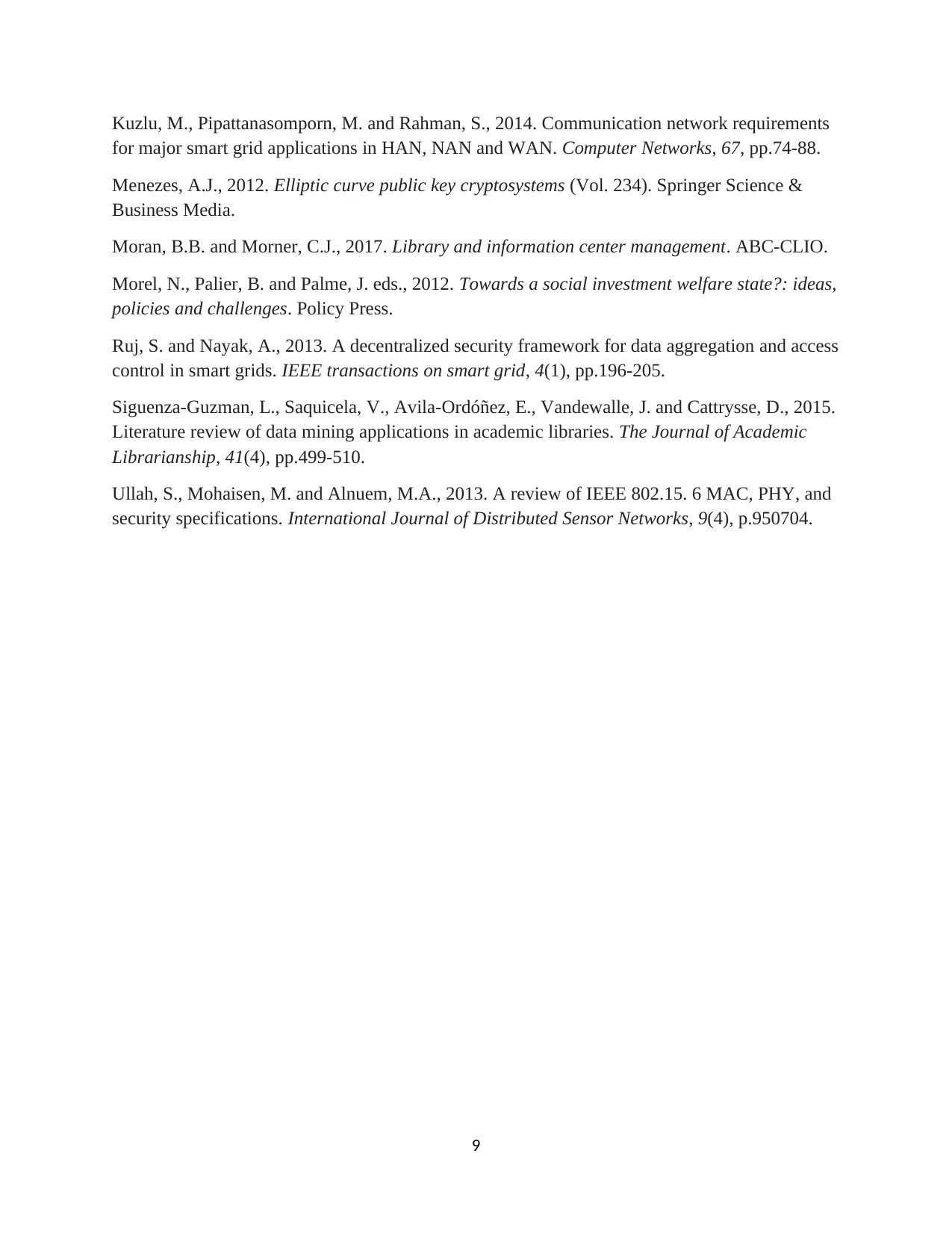
Kuzlu, M., Pipattanasomporn, M. and Rahman, S., 2014. Communication network requirements
for major smart grid applications in HAN, NAN and WAN. Computer Networks, 67, pp.74-88.
Menezes, A.J., 2012. Elliptic curve public key cryptosystems (Vol. 234). Springer Science &
Business Media.
Moran, B.B. and Morner, C.J., 2017. Library and information center management. ABC-CLIO.
Morel, N., Palier, B. and Palme, J. eds., 2012. Towards a social investment welfare state?: ideas,
policies and challenges. Policy Press.
Ruj, S. and Nayak, A., 2013. A decentralized security framework for data aggregation and access
control in smart grids. IEEE transactions on smart grid, 4(1), pp.196-205.
Siguenza-Guzman, L., Saquicela, V., Avila-Ordóñez, E., Vandewalle, J. and Cattrysse, D., 2015.
Literature review of data mining applications in academic libraries. The Journal of Academic
Librarianship, 41(4), pp.499-510.
Ullah, S., Mohaisen, M. and Alnuem, M.A., 2013. A review of IEEE 802.15. 6 MAC, PHY, and
security specifications. International Journal of Distributed Sensor Networks, 9(4), p.950704.
9
for major smart grid applications in HAN, NAN and WAN. Computer Networks, 67, pp.74-88.
Menezes, A.J., 2012. Elliptic curve public key cryptosystems (Vol. 234). Springer Science &
Business Media.
Moran, B.B. and Morner, C.J., 2017. Library and information center management. ABC-CLIO.
Morel, N., Palier, B. and Palme, J. eds., 2012. Towards a social investment welfare state?: ideas,
policies and challenges. Policy Press.
Ruj, S. and Nayak, A., 2013. A decentralized security framework for data aggregation and access
control in smart grids. IEEE transactions on smart grid, 4(1), pp.196-205.
Siguenza-Guzman, L., Saquicela, V., Avila-Ordóñez, E., Vandewalle, J. and Cattrysse, D., 2015.
Literature review of data mining applications in academic libraries. The Journal of Academic
Librarianship, 41(4), pp.499-510.
Ullah, S., Mohaisen, M. and Alnuem, M.A., 2013. A review of IEEE 802.15. 6 MAC, PHY, and
security specifications. International Journal of Distributed Sensor Networks, 9(4), p.950704.
9
⊘ This is a preview!⊘
Do you want full access?
Subscribe today to unlock all pages.

Trusted by 1+ million students worldwide
1 out of 12
Related Documents
Your All-in-One AI-Powered Toolkit for Academic Success.
+13062052269
info@desklib.com
Available 24*7 on WhatsApp / Email
![[object Object]](/_next/static/media/star-bottom.7253800d.svg)
Unlock your academic potential
Copyright © 2020–2025 A2Z Services. All Rights Reserved. Developed and managed by ZUCOL.





